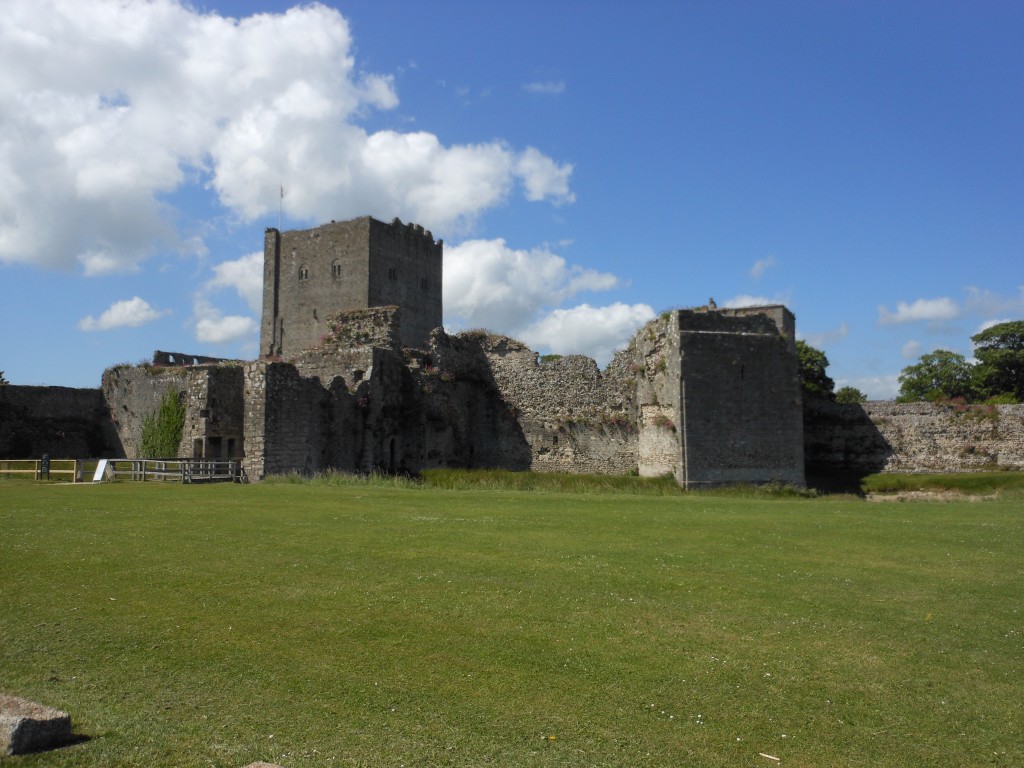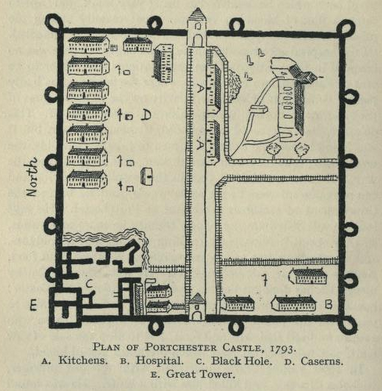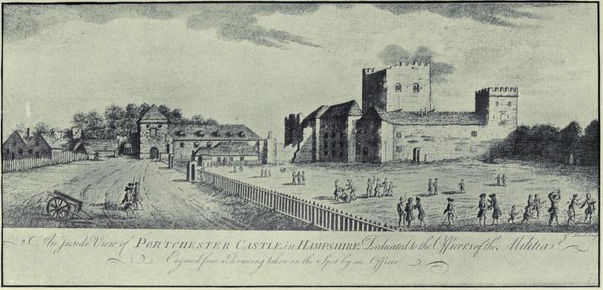Portchester Castle is a striking relic of Roman and Norman architecture. It holds position, still dominating the landscape at the head of Portsmouth Harbour.
The long history of Portchester Castle is as varied and interesting as for any castle in England. Over time its function has changed and when you visit you quickly become aware of its role as a prison. It was never a planned prison but with a structure that included walls 6′ – 10′ thick and 15′ – 40′ high, it was an obvious choice. Its proximity to the sea was both a blessing and a concern. Escape across the Channel and back to the Continent must have seemed like a very attractive proposition to the French and Spanish prisoners held here and many attempts were made to break out, although not many were successful.
It is probably the oldest prisoner of war prison in Britain and we know quite a lot about what it was like, accounts from French POW representatives, prisoners and those who guarded them give a colourful picture of life in the C18th castle.
In 1745 the Gentleman’s Magazine, report of an escape by Spanish prisoners but the work of Porchester Castle as a prison really began during the seven years war.
Contemporary accounts paint a colourful picture of life in Portchester Castle prison
A fascinating account comes from Captain Fraboulet, a medical representative on board the captured French East Indian frigate the Astree. He reported that provisions at Porchester Castle were good, except for the small beer, which he thought very weak and liable to cause a ‘flux’ of the blood. He managed to get it strengthened but was still unhappy with parts of the prisoners diet. He wanted the provision of raw fruit and salted fish banned and withdrew the King’s Bounty (the small amount of money paid out by the French monarch to each prisoner) from the ill as he thought they were purchasing unwholesome food.
He rebuked the Porchester Castle authorities for the lack of hospital accommodation, there was no hospital within the castle itself. The sick were either transported to Fareham hospital, a sorry wooden affair on the muddy foreshore of the river or to Forton, some seven miles away alongside pitted and muddy roads, many not surviving the journey.
In 1784, Portchester castle was properly set up as a war prison, the moat was cleared and filled with water and the keep divided into five stories with accommodation for 8,000 prisoners. The large tower housed 1200 to 1500 men and there were nine barracks containing 500 men a piece.
Although it was a tough prison, most records show that there was no outward brutality shown towards those captured here, although a fair share of murders and attempted murders between prisoners themselves and those guarding them took place.
The prison and local life
The local population saw the prison as an opportunity to buy and barter with the prisoners, who fashioned many beautiful goods from the most meager of supplies. There were manufacturers of straw hats, shoes, gloves and bone ornaments but perhaps the most skilled were the lace makers. It is said these totaled 3000 men, whose work was so fine and beautiful that local lace makers were put out of work and the lace making in the prison was brutally suppressed by destroying the lace makers machines.
Each day a local market was held where local eggs and dairy products were procured through barter, a marionette show or Punch and Judy in exchange for half a dozen eggs!
Once or twice a week the castle yard opened for local people to buy the trinkets and it seems the church yard was also a splendid place to but a straw bonnet or two.
Sanitary conditions were poor though and there were frequent outbreaks of disease. In 1800 the record of sickness and mortality was particularly great. By 1810 the prison was declared overcrowded and the number of prisoners reduced from 8000 to 5100.
So the prison at Portchester Castle was a strange mix of people, its relationship with the local population complex. When ships were taken, any non combatants on board, were placed in houses in the village, with the result that there were several marriages between french ladies and English gents.
Other prisoners who had spent some time at the prison were sent to other parole towns in Hampshire, including Alresford.
The last french prisoners left the castle in May 1814 and the last Americans in 1816, at this point all wooden buildings were taken down and sold. It is said that some were used as housing in Fareham.
Many will have died at the castle but their burials are not recorded. It is believed they were buried in unmarked mass graves or placed on the shoreline to be taken by the tide. Whatever the castle might have been before in its 1500 year history, its time as a prison was probably one of Portchester Castle more colourful periods of history.
History in Hampshire – places nearby
Portchester Castle is run by English Heritage and is a splendid day out, another good reason to explore Hampshire history. Across the water visit the new Mary Rose exhibition and Nelson’s flagship HMS Victory.



